利用jvisualvm.exe搞一个关于生产者消费者的一个纠结的问题
先看代码:
package com.wlf.service; import java.util.LinkedList; import java.util.Queue; import java.util.concurrent.LinkedBlockingQueue; /** * 生产者消费者模拟 * * @author wulf * @since 20200708 */ public class LinkedBlockingQueueTest { public static void main(String[] args) { Puter puter = new Puter(); // 生产者放(put)对象到队列中 Poller poller = new Poller(); // 消费者从队列中取对象(poll) // 消费者线程,把生产者对象加为属性,以便获取生产者队列 Thread thread1 = new Thread(() -> { System.out.println("I'm coming thread1...."); poller.setPuter(puter); poller.doPoll(); }); // 生产者线程,把消费者线程加为属性,以便生产发动后再去发动消费者线程 Thread thread2 = new Thread(() -> { System.out.println("I'm coming thread2...."); puter.setThread(thread1); try { puter.doPut(); } catch (InterruptedException e) { e.printStackTrace(); } }); // 发动生产者线程 thread2.start(); } } /** * 生产者 */ class Puter { // 解耦生产者、消费者的队列 private Queue<Integer> linkedQueue = new LinkedList<>(); // private Queue<Integer> linkedQueue = new LinkedBlockingQueue<>(); // 消费者线程 private Thread thread; // 生产者已经启动生产标志位,默认是启动状态 private boolean isStarted = true; public Queue<Integer> getLinkedQueue() { return linkedQueue; } public void setThread(Thread thread) { this.thread = thread; } public boolean isStarted() { return isStarted; } public void doPut() throws InterruptedException { Thread.sleep(1000); // 生产者准备一下,开始生产 // 准备完成,启动消费者线程拉取poll if (thread != null) { System.out.println("thread not null...."); thread.start(); } Thread.sleep(20); // 这里很关键,生产者还得稍微准备一下,这就让消费者先去拉取一个空队列了 for (int i = 0; i < 10000; i++) { Thread.sleep(2); // 模拟生产耗时 linkedQueue.offer(i); System.out.println("producer put success: " + i); } isStarted = false; // 生产结束了,告诉消费者 System.out.println("producing over."); } } /** * 消费者 */ class Poller { private Puter puter; public void setPuter(Puter puter) { this.puter = puter; } public void doPoll() { // 队列不为空,或者生产已经开始生产,那么就去消费它,拉取队列中的对象 while (puter.getLinkedQueue().size() > 0 || puter.isStarted()) { Integer element = puter.getLinkedQueue().poll(); // 如果拉取到的对象是null,跳过继续拉取 if (element == null) { continue; } // 不为null,拉取成功 System.out.println("consumer poll success: " + element); } // 消费结束了,结束流程 System.out.println("Game is over."); } }
运行现象:打印出了所有生产者对象,消费者一个不打,而且进程没有结束,卡着不动
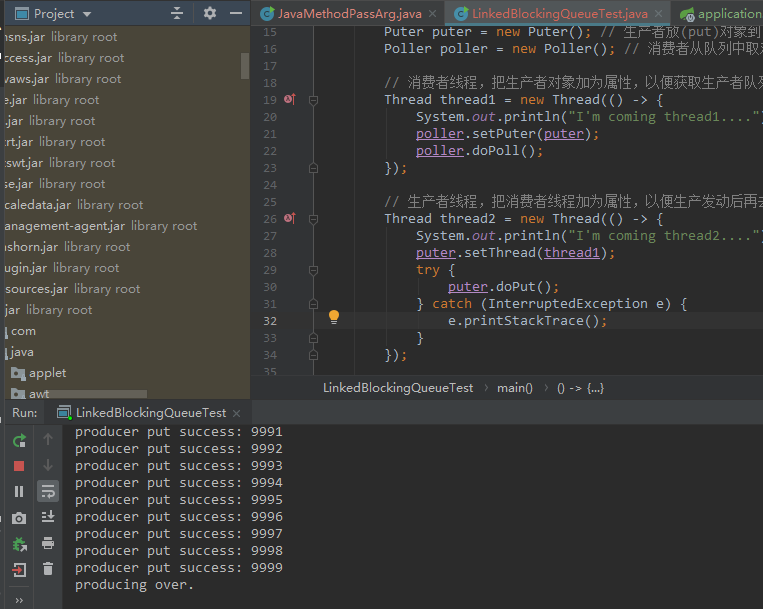
这是一个生产者消费者问题,模型简单,通过一个队列LinkedList来当中间人,它传递生产者的产品给消费者消费。打个经典的比方,生产者是洗碗工,消费者是擦盘工,队列是传送带。洗碗工只管埋头洗碗,擦盘工只管埋头擦碗,如果用隔板把他们隔开来,中间只有一个传送带,他们甚至可能都不认识彼此,因为他们只认识传送带。
现在问题不在生产者,因为它正常打印出来了,那么消费者怎么回事,它为啥就给自己放假了?其实我们误会消费者了,人家也在很努力的干活,只不过我们看不见罢了。它在干什么活?毫无意义的活,浪费CPU的资源的空转。
接下来需要借用JDK自带的JVisualVM这个工具来看一看消费者在做啥,在java的jdk目录下bin目录里,双击jvisualvm.exe运行:
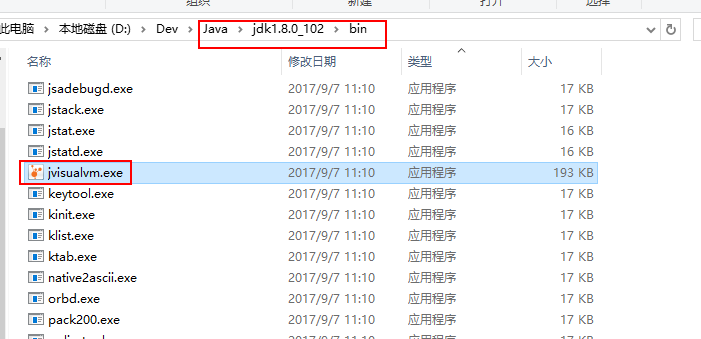
右键点击我们的程序,点击“线程Dump”:

这是刚开始生产者还在运行时的情况:
2020-07-08 20:37:48 Full thread dump Java HotSpot(TM) 64-Bit Server VM (25.102-b14 mixed mode): "Thread-0" #11 prio=5 os_prio=0 tid=0x000000001a9c2800 nid=0x9380 runnable [0x000000001bb6f000] java.lang.Thread.State: RUNNABLE at com.wlf.service.Poller.doPoll(LinkedBlockingQueueTest.java:108) at com.wlf.service.LinkedBlockingQueueTest.lambda$main$0(LinkedBlockingQueueTest.java:22) at com.wlf.service.LinkedBlockingQueueTest$$Lambda$1/1156060786.run(Unknown Source) at java.lang.Thread.run(Thread.java:745) Locked ownable synchronizers: - None "DestroyJavaVM" #13 prio=5 os_prio=0 tid=0x00000000034a4000 nid=0x82c8 waiting on condition [0x0000000000000000] java.lang.Thread.State: RUNNABLE Locked ownable synchronizers: - None "Thread-1" #12 prio=5 os_prio=0 tid=0x000000001a380000 nid=0x4a98 waiting on condition [0x000000001ba6f000] java.lang.Thread.State: TIMED_WAITING (sleeping) at java.lang.Thread.sleep(Native Method) at com.wlf.service.Puter.doPut(LinkedBlockingQueueTest.java:81) at com.wlf.service.LinkedBlockingQueueTest.lambda$main$1(LinkedBlockingQueueTest.java:30) at com.wlf.service.LinkedBlockingQueueTest$$Lambda$2/1709537756.run(Unknown Source) at java.lang.Thread.run(Thread.java:745) Locked ownable synchronizers: - None "Service Thread" #10 daemon prio=9 os_prio=0 tid=0x000000001a128000 nid=0x5dfc runnable [0x0000000000000000] java.lang.Thread.State: RUNNABLE Locked ownable synchronizers: - None
我们看到生产者线程是“Thread-1”,消费者是“Thread-0”。生产者因为生产者过程中需要休眠两毫秒,所以我们看到它是在休眠状态中,其实它是有在干活的,只不过干活的速度相比休眠太快了,就像白驹过隙,所以我们只看到了他在睡觉的假象,还好有日志证明了他的清白。消费者则相反,我们看到它在运行状态中,好像他一直在干活,但没有任何成果,所以他其实是在划水,一直在辛苦的空转着:
while (puter.getLinkedQueue().size() > 0 || puter.isStarted()) { Integer element = puter.getLinkedQueue().poll(); // 如果拉取到的对象是null,跳过继续拉取 if (element == null) { continue; } // 不为null,拉取成功 System.out.println("consumer poll success: " + element); }
上面标黄的地方就是消费者马不停蹄的做是事情。看似勤奋的消费者,做的确实劳而无功的事情。我们可以看下拉长时间线看下线程的运行状态:
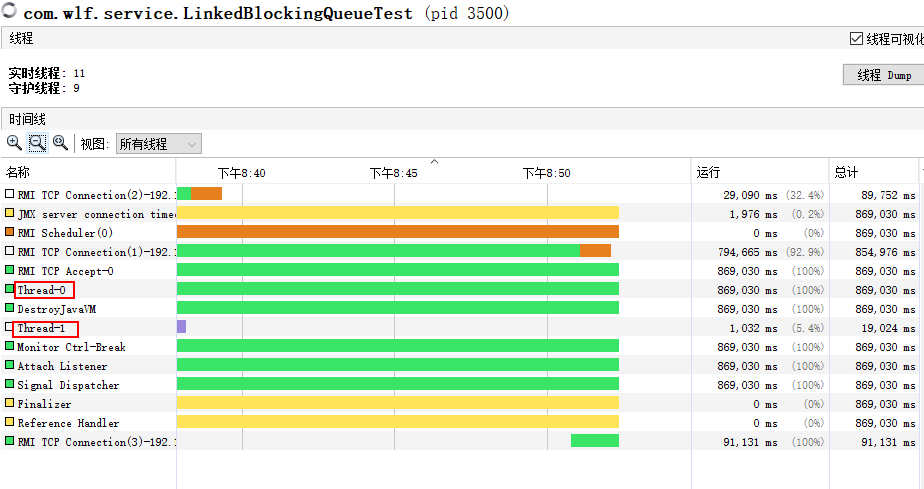
绿色的条条就是运行状态,蓝色的是休眠状态。这个上面我们的分析吻合。可是为啥消费者要偷偷划水?继续看内存堆的情况,点击“堆Dump”:
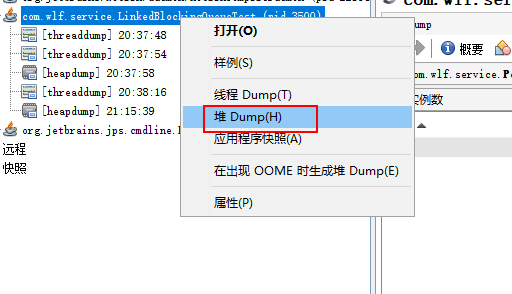
点击左上角的“类”,再点击“实例..."右边的三角形排个序,先找到只有实例数为1的类,再找到我们的生产者和消费者类:

这时消费者程序已经空转很久了,双击消费者类“Poller”进入实例数,我们看看消费者实例的属性,特别是工作队列的情况:
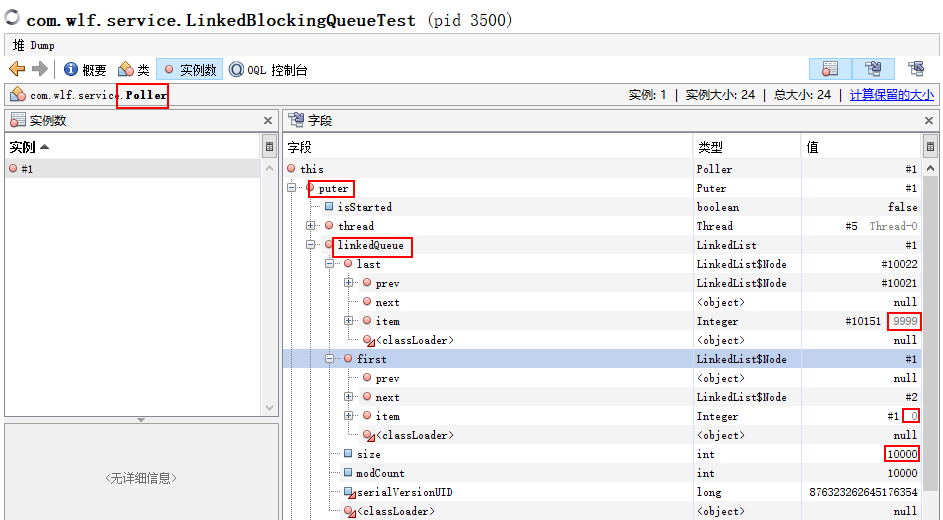
我们可以发现,队列已经满了,第一个元素是0,最后一个9999,队列大小10000,没有任何问题。我们发现过了很久,队列依然一直是满的,令人费解的消费者,队列明明有数据,而他为何不从队列中取出对象来消费?说来话长,回头看我们的代码,罪魁祸首仍然是LinkedList队列:
Thread.sleep(20); // 这里很关键,生产者还得稍微准备一下,这就让消费者先去拉取一个空队列了
看看LinkedList趁着生产者眯眼的这20毫秒的准备时间中,消费者做了什么?
while (puter.getLinkedQueue().size() > 0 || puter.isStarted()) { Integer element = puter.getLinkedQueue().poll(); // 如果拉取到的对象是null,跳过继续拉取 if (element == null) { continue; }
没错,消费者先去拉取队列中的元素了,而此时生产者尚未准备好,队列只能是空的,毫无疑问,element是一个null。看看poll的源码,它很关键,消费者空转的源头:
/** * Retrieves and removes the head (first element) of this list. * * @return the head of this list, or {@code null} if this list is empty * @since 1.5 */ public E poll() { final Node<E> f = first; return (f == null) ? null : unlinkFirst(f); }
unlinkFirst方法我们不用看,因为此时first是null,poll返回的就是null,然后几乎没有停顿又来到poll方法,因为CPU中间没有其他事情可以做。所以unlinkFirst永远不会进去,poll方法得到的element一直是null。因为每次取到一个null就去continue,所以就死循环了,CPU只能空转。为什么?上面堆里的实例不是看到LinkedList的first是0吗?是的,但那是后来生产者线程放进去的,放进去后它通知了消费者线程了吗?并没有,不信我们去看看offer的源码,最后来到这里:
/** * Links e as last element. */ void linkLast(E e) { final Node<E> l = last; final Node<E> newNode = new Node<>(l, e, null); last = newNode; if (l == null) first = newNode; else l.next = newNode; size++; modCount++; }
我们看到无论是poll还是offer,都是线程不安全的。offer方法是给first赋值了,但此时消费者是毫不知情的,它依然蒙在鼓里,还在疯狂的循环中,它根本没有一刻的闲暇来看一眼队列的最新情况,只能取到一个过去的、老去的空队列。这就是并发,生产者在往队列中放对象的同时,消费者在取对象,可以看做它们对同一个队列分别做新增和删除操作,但彼此不知道对方在做什么,因为这个队列对这两个线程来说就是一个共享资源,而且是没有加锁、没有通知的竞态资源。
接下来我们来看一个极端:把生产者的生产数目改下,从一万改为一,可以看到同样的事情还是发生了,因为消费者先去执行,从队列里取出了一个null,接下去就是空转:

堆内存的实例属性显示队列此时只有一个元素0:

消费者在空转:

怎么破?解决并发安全性问题的通用做法很简单,使用一个线程安全的队列,比如LinkedBlockingQueue。看看人家的源码就知道了:
/** * Inserts the specified element at the tail of this queue if it is * possible to do so immediately without exceeding the queue's capacity, * returning {@code true} upon success and {@code false} if this queue * is full. * When using a capacity-restricted queue, this method is generally * preferable to method {@link BlockingQueue#add add}, which can fail to * insert an element only by throwing an exception. * * @throws NullPointerException if the specified element is null */ public boolean offer(E e) { if (e == null) throw new NullPointerException(); final AtomicInteger count = this.count; if (count.get() == capacity) return false; int c = -1; Node<E> node = new Node<E>(e); final ReentrantLock putLock = this.putLock; putLock.lock(); try { if (count.get() < capacity) { enqueue(node); c = count.getAndIncrement(); if (c + 1 < capacity) notFull.signal(); } } finally { putLock.unlock(); } if (c == 0) signalNotEmpty(); return c >= 0; }
public E poll() { final AtomicInteger count = this.count; if (count.get() == 0) return null; E x = null; int c = -1; final ReentrantLock takeLock = this.takeLock; takeLock.lock(); try { if (count.get() > 0) { x = dequeue(); c = count.getAndDecrement(); if (c > 1) notEmpty.signal(); } } finally { takeLock.unlock(); } if (c == capacity) signalNotFull(); return x; }
其他不动,把生产者Puter类改一行代码:
// 解耦生产者、消费者的队列 // private Queue<Integer> linkedQueue = new LinkedList<>(); private Queue<Integer> linkedQueue = new LinkedBlockingQueue<>();
再次运行,结果如预期:
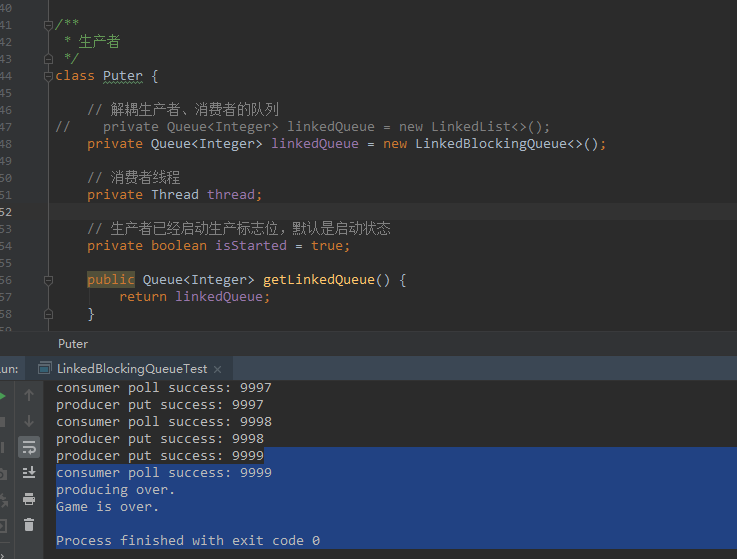
另一种解法不够安全,但能让我们搞明白这个问题的其他变种。见利用jvisualvm.exe搞一个关于生产者消费者的另一些纠结的问题



